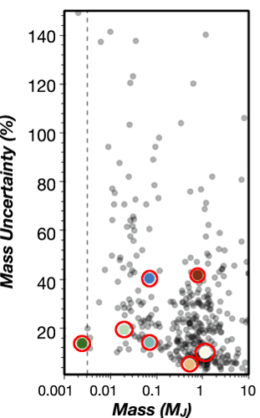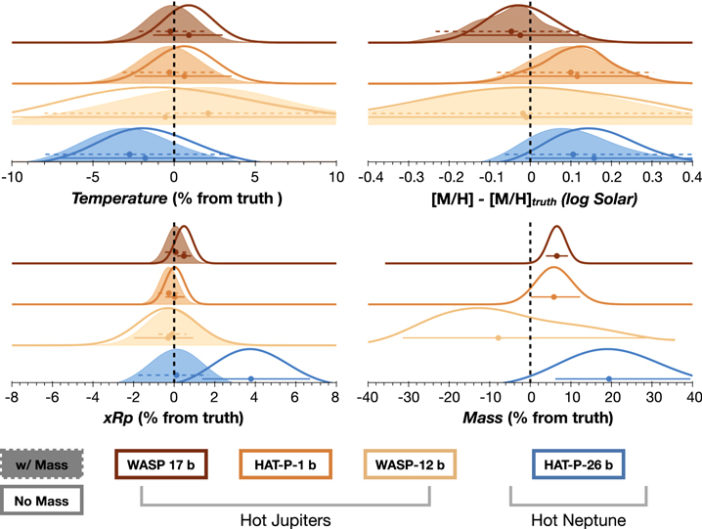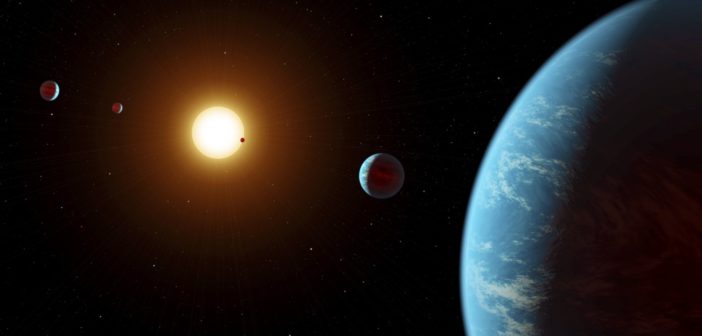One of the goals of the Transiting Exoplanet Survey Satellite (TESS) is to identify exoplanets whose atmospheres can be characterized by other telescopes. Part of this process entails measuring planetary masses to some degree of precision. So just how well do we need to know an exoplanet’s mass to understand its atmosphere?
The Use of Transmission Spectra
One way to study the atmosphere of an exoplanet is to observe the light from its host star that passes through the planet’s atmosphere. Comparing the resulting spectrum — called a transmission spectrum — with the spectrum of the host star alone can tell us about what’s in the planet’s atmosphere.
A planet’s mass plays an important role in how far its atmosphere extends. This has prompted studies on whether a planet’s mass could be inferred from its transmission spectrum alone. In some cases, this approach works. But in other cases, the transmission spectra of very different planets can appear to be alike.

The precision of exoplanet mass measurements versus their most likely mass. The seven planets used in this study are highlighted. [Adapted from Batalha et al. 2019]
Seven Special Planets
For their study, Batalha and collaborators chose seven known planets that span the gamut of exoplanets we’ve observed. Their sample included three hot Jupiters (WASP-17b, HAT-P-1b, WASP-12b), three Neptune-like planets (HAT-P-26 b, GJ 436b, GJ 1214b), and one Earth-like planet (TRAPPIST-1e).
To simulate transmission spectra, the authors started with models that are consistent with Hubble spectroscopy of their chosen planets. They then used these models to simulate the analogous JWST spectra.
Aside from mass, the sample planets also varied in composition. Their host stars are also different, meaning that in real life the JWST would have to adopt different observing strategies to get quality transmission spectra.

The accuracy with which different atmospheric properties are recovered from the simulated transmission spectra. From top left, clockwise: temperature, metallicity (the abundance of elements that are not hydrogen or helium), radius, and mass. The shaded regions correspond to mass being known and the unfilled regions correspond to mass not being known. The colors of the curves indicate different planets. Click to enlarge. [Batalha et al. 2019]
A Matter of Caution
To test what role mass played in the usefulness of transmission spectra, the authors attempted to measure atmospheric properties from their modeled spectra. They tried different precisions on mass (how far off the assumed mass could be from the true mass) as well as not knowing a planet’s mass at all.
The authors found that transmission spectra alone could not reliably characterize a planet’s atmosphere. Hot Jupiters required the loosest mass constraints to infer atmospheric properties, though cloud cover — such as in the case of WASP-12b — could make that untrue. For the other Neptunes and the Earth-like planet, mass had to be known with at least a 50% precision to get accurate atmospheric properties.
A recurring theme was that a mass measurement is necessary to distinguish one planet from others with similar transmission spectra. To this end, the authors recommend that any planets selected for atmospheric characterization have their mass known to at least 50% precision.
One of TESS’s goals is to measure the mass of fifty Earth-sized planets, and Batalha and collaborators have set a benchmark for those measurements. This sort of groundwork is critical to exoplanet science and should contribute to great results not too long from now!
Citation
“The Precision of Mass Measurements Required for Robust Atmospheric Characterization of Transiting Exoplanets,” Natasha E. Batalha et al 2019 ApJL 885 L25. https://doi.org/10.3847/2041-8213/ab4909

1 Comment
Pingback: From AAS NOVA: “Mass-ive Implications for Exoplanetary Atmospheres” | sciencesprings